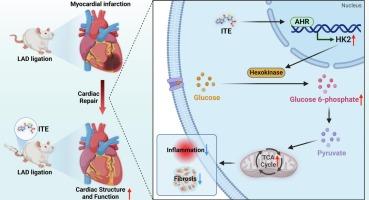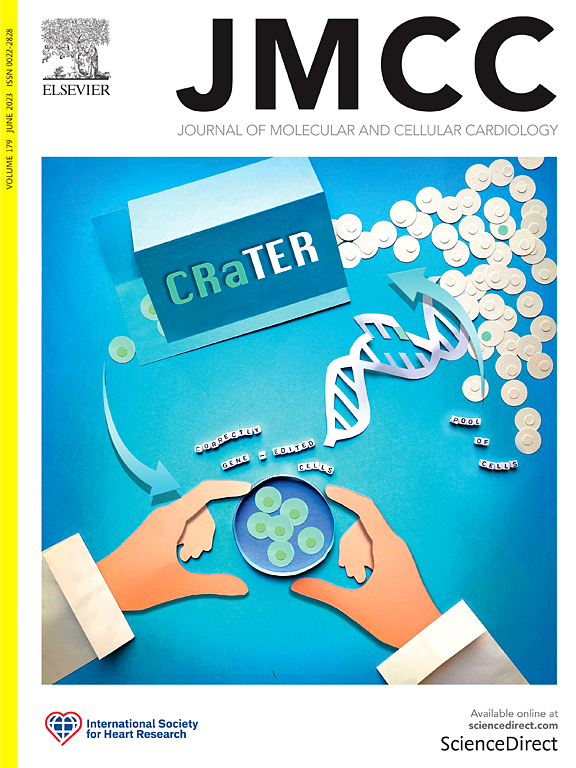芳烃受体激活对梗死后心肌代谢、炎症和纤维化的有益影响:来自多组学的意义。
IF 4.7
2区 医学
Q1 CARDIAC & CARDIOVASCULAR SYSTEMS
引用次数: 0
摘要
背景:梗死后代谢改变、炎症反应和纤维化是不良心脏重构的关键因素。2-(1‘ h -吲哚-3’羰基)-噻唑-4-羧酸甲酯(ITE)是芳烃受体(AHR)的配体,已被证明能有效激活AHR,但其在心肌梗死(MI)中的作用和机制尚不清楚。方法:结扎左冠状动脉前支,建立心肌梗死模型,给药4 周。超声心动图和血流动力学监测评估心脏结构和功能。苏木精-伊红和马松三色法检测形态学和胶原沉积。透射电镜观察线粒体形态。转录组和代谢组用于筛选关键靶点和途径。使用缺氧新生大鼠心肌细胞和成纤维细胞模型联合腺病毒AHR敲低来验证关键靶点和途径。结果:ITE干预显著改善心肌梗死大鼠心脏结构和功能、线粒体形态、纤维化和炎症。多组学显示,差异表达的基因和代谢物在糖代谢相关途径中富集,并确定了一个关键靶点HK2。与心肌梗死组相比,ITE可显著改善心肌梗死后糖代谢关键酶的表达。体外实验中,ITE和tapinarof激活AHR可显著改善缺氧诱导的HK2、CISY、OGDH、纤维化和炎症标志物异常,而己糖激酶抑制剂可消除ITE的有益作用。此外,AHR敲低会损害葡萄糖代谢,促进炎症和纤维化。结论:ITE激活AHR可减轻心肌梗死后的炎症和纤维化,通过促进HK2和糖代谢改善心肌结构和功能。本文章由计算机程序翻译,如有差异,请以英文原文为准。

Beneficial effects of aryl hydrocarbon receptor activation on post-infarction myocardial metabolism, inflammation and fibrosis: implications from multi-omics
Background
Post-infarction metabolism changes, inflammatory responses, and fibrosis are crucial contributors to adverse cardiac remodeling. 2-(1′H-indole-3′‑carbonyl)-thiazole-4-carboxylic acid methyl ester (ITE), the aryl hydrocarbon receptor (AHR) ligand, has demonstrated effective AHR activation, yet its impact and mechanisms in myocardial infarction (MI) remain unclear.
Methods
The MI model was established by ligating left anterior coronary artery, and ITE was administered for 4 weeks. Echocardiography and hemodynamic monitoring were used to assess cardiac structure and function. Hematoxylin-eosin and Masson's trichrome were used to examine morphology and collagen deposition. Transmission electron microscopy was employed to examine mitochondrial morphology. The transcriptome and metabolome were used to screen for key targets and pathways. Hypoxic neonatal rat cardiomyocytes and fibroblasts models combined with adenoviral AHR knockdown were used to verify key targets and pathways.
Results
ITE intervention significantly improved cardiac structure and function, mitochondrial morphology, fibrosis and inflammation in MI rats. Multi-omics revealed that differentially expressed genes and metabolites were enriched in glucose metabolism related pathways and identified a key target, HK2. Compared to MI group, ITE significantly improved the expression of key enzymes in glucose metabolism after MI. In vitro, AHR activation by ITE and tapinarof significantly ameliorated hypoxia-induced abnormalities in HK2, CISY, OGDH, fibrosis, and inflammatory markers, while hexokinase inhibitor eliminated the beneficial effects of ITE. Moreover, AHR knockdown impairs glucose metabolism and promotes inflammation and fibrosis.
Conclusion
The AHR activation by ITE mitigates inflammation and fibrosis, improves cardiac structure and function by promoting HK2 and glucose metabolism after MI.
求助全文
通过发布文献求助,成功后即可免费获取论文全文。
去求助
来源期刊
CiteScore
10.70
自引率
0.00%
发文量
171
审稿时长
42 days
期刊介绍:
The Journal of Molecular and Cellular Cardiology publishes work advancing knowledge of the mechanisms responsible for both normal and diseased cardiovascular function. To this end papers are published in all relevant areas. These include (but are not limited to): structural biology; genetics; proteomics; morphology; stem cells; molecular biology; metabolism; biophysics; bioengineering; computational modeling and systems analysis; electrophysiology; pharmacology and physiology. Papers are encouraged with both basic and translational approaches. The journal is directed not only to basic scientists but also to clinical cardiologists who wish to follow the rapidly advancing frontiers of basic knowledge of the heart and circulation.

 求助内容:
求助内容: 应助结果提醒方式:
应助结果提醒方式:


